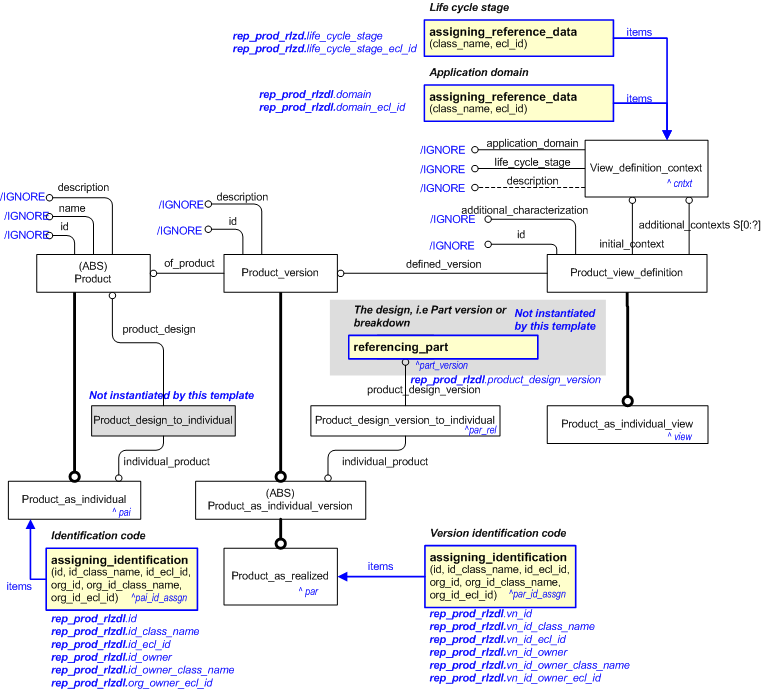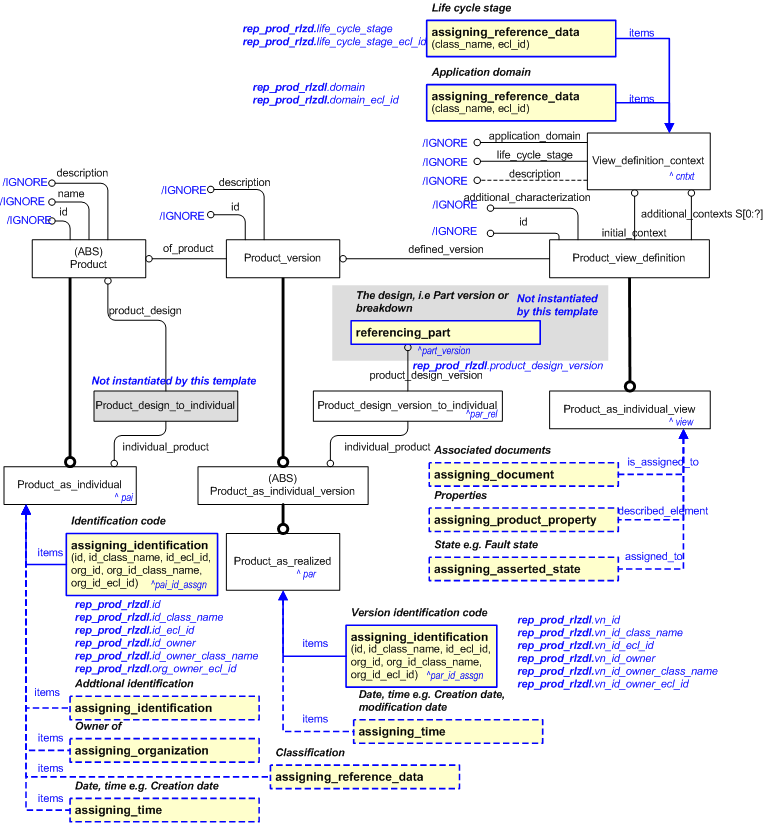| Template:— representing_product_as_realized (rep_prod_rlzd) |
Date: 2008/03/01 11:23:57
Revision: 1.34
|
This section specifies the template representing_product_as_realized.
NOTE
An explanation of a template and the associated instantiation path is
provided in the
Template overview
section.
This template describes the representation of a real physical product,
an artifact, using the
Product_as_realized
entity.
It enables the identification of the physical product and its relation to the Part where the
Part represents the design or specification that was used to manufacture the physical
product, normally identified by a part number.
The template also defines the how reference data, dates, properties, documents, etc. are
assigned to the physical product.
NOTE
If an organization does not version
Product_as_individuals,
it is recommended that the identification of the
Product_as_realized
is set to "/NULL", i.e. the attribute
identifier
of entity Identification_assignment
contain the string "/NULL" (see C001: assigning_identifiers (NB Capabilities are not documented in this release of the PLCS standard)
), to indicate
that no version information is relevant or intended. In this case, (historical) changes to the real product cannot
be tracked
without changing the identifier of the product_as_individual (e.g. the serial number).
NOTE
If the Part is not known, then it is recommended to use the template
referencing_part
with the identifier parameters set to "/NULL" to indicate that the Part is not known.
The EXPRESS-G diagram in
Figure
1
shows the templates and EXPRESS entities that are required
to represent the template
"representing_product_as_realized".
The text highlighted in blue shows the template parameters.
Grey areas and templates with dashed lines are not included in the template, but may be used to further
characterize the template.
Figure 1 — An EXPRESS-G representation of the Information model for Product_as_realized
The graphic for the template to be used in other EXPRESS-G diagrams
is shown in Figure
2
below.
Figure 2 —
The graphical representation of representing_product_as_realized template
The following input parameters are defined for this template:
The identifier of the Product_as_individual, e.g. serial number.
The name of the class being used to classify the identification
(
Identification_assignment)
of the individual product. This provides the role or reason for the identification.
The following classes and their sub-classes can be used:
id_ecl_id (Default=urn:plcs:rdl:std,Type='URN')
The identifier of the
External_class_library
storing the definition of the class referenced by the parameter @id_class_name class.
The name or identifier of the organization owning the id or name.
The name of the class being used to classify the
identification of the organization. For example CAGE code, or organization name.
The following classes and their sub-classes can be used:
vn_id (Default=/NULL,Type='STRING')
The identifier of the Product_as_realized, e.g. version marking, modification status.
vn_id_class_name (Default=Product_as_individual_identification_code,Type='CLASS')
The name of the class being used to classify the identification
(
Identification_assignment)
of the product_as_realized (a version of the individual product). This provides the role or reason for the identification.
The following classes and their sub-classes can be used:
The identifier of the
External_class_library
storing the definition of the class referenced by the parameter @vn_id_class_name class.
The name or identifier of the organization owning the version_id.
The name of the class being used to classify the
identification of the organization. For example CAGE code, or organization name.
The following classes and their sub-classes can be used:
The following classes and their sub-classes can be used:
The identifier of the
External_class_library
storing the definition of the class referenced by the parameter @life_cycle_stage class.
domain (Default=Product_life_cycle_support,Type='CLASS')
The following classes and their sub-classes can be used:
The identifier of the
External_class_library
storing the definition of the class referenced by the parameter @domain class.
The following reference parameters are defined for this template:
Allow the
Product_as_individual
entity instantiated in this path to be referenced when this template is used.
%^target = $representing_product_as_realized.pai%
%^target = $representing_product_as_realized.pai_id_assgn%
Allow the
Product_as_realized
entity instantiated in this path to be referenced when this template is used.
%^target = $representing_product_as_realized.par%
%^target = $representing_product_as_realized.par_id_assgn%
%^target = $representing_product_as_realized.par_rel%
%^target = $representing_product_as_realized.view%
%^target = $representing_product_as_realized.cntxt%
The following parameter combinations specify a uniqueness constraint:
Unique constraint: Unique product as individual
Unique constraint: Unique product as individual view
There shall be at most one instance of the
entity
(
Product_as_individual_view)
within the data set uniquely identified
by a combination of the following parameters on this
template (representing_product_as_realized) namely:
id,
id_class_name,
id_ecl_id,
id_owner,
id_owner_class_name,
id_owner_ecl_id,
vn_id,
vn_id_class_name,
vn_id_ecl_id,
vn_id_owner,
vn_id_owner_class_name,
vn_id_owner_ecl_id,
domain,
domain_ecl_id,
life_cycle_stage,
life_cycle_stage_ecl_id.
The
instance is
referenced by the following template parameter:
view.
Unique constraint: Unique product as realized
There shall be at most one instance of the
entity
(
Product_as_realized)
within the data set uniquely identified
by a combination of the following parameters on this
template (representing_product_as_realized) namely:
id,
id_class_name,
id_ecl_id,
id_owner,
id_owner_class_name,
id_owner_ecl_id,
vn_id,
vn_id_class_name,
vn_id_ecl_id,
vn_id_owner,
vn_id_owner_class_name,
vn_id_owner_ecl_id.
The
instance is
referenced by the following template parameter:
par.
Unique constraint: Unique view_definition_context
The instantiation path shown below specifies the entities that are to be
instantiated by the template.
-- instantiate Product_as_individual Product_as_individual%^pai =
Product_as_individual%
^pai.id = '/IGNORE'
^pai.name = '/IGNORE'
^pai.description = '/IGNORE'
-- assign identifier to individual /
assigning_identification(
id=@id,
id_class_name=@id_class_name,
id_ecl_id=@id_ecl_id,
org_id=@id_owner,
org_id_class_name=@id_owner_class_name,
org_id_ecl_id=@id_owner_ecl_id,
items=^pai)/
%^pai_id_assgn = $assigning_identification.id_assgn%
-- instantiate Product_as_realized Product_as_realized%^par =
Product_as_realized%
^par.id = '/IGNORE'
^par.description = '/IGNORE'
^par.of_product ->
^pai
-- assign version identifier to Product_as_realized /
assigning_identification(
id=@vn_id,
id_class_name=@vn_id_class_name,
id_ecl_id=@vn_id_ecl_id,
org_id=@vn_id_owner,
org_id_class_name=@vn_id_owner_class_name,
org_id_ecl_id=@vn_id_owner_ecl_id,
items=^par)/
%^par_id_assgn = $assigning_identification.id_assgn%
-- instantiate Product_as_individual_view Product_as_individual_view%^view =
Product_as_individual_view%
^view.id = '/IGNORE'
^view.name = '/IGNORE'
^view.additional_characterization = '/IGNORE'
Product_as_individual_view.defined_version ->
^par
-- instantiate View_definition_context and bind it to the view Product_as_individual_view.initial_context ->
View_definition_contextView_definition_context.life_cycle_stage = '/IGNORE'
View_definition_context.application_domain = '/IGNORE'
View_definition_context.description = '/IGNORE'
%^cntxt =
View_definition_context%
-- assign life_cycle_stage to the context /
assigning_reference_data(
items=View_definition_context,
class_name=@life_cycle_stage,
ecl_id=@life_cycle_stage_ecl_id)/
-- assign application_domain to the context /
assigning_reference_data(
items=View_definition_context,
class_name=@domain,
ecl_id=@domain_ecl_id)/
-- instantiate Product_design_version_to_individual Product_design_version_to_individual%^par_rel =
Product_design_version_to_individual%
Product_design_version_to_individual.individual_product ->
^par
Product_design_version_to_individual.product_design_version ->
@product_design_version
The following entities are instantiated with attributes as specified:
The instance diagram in Figure
3
shows an example of the EXPRESS entities and templates that are instantiated by the template:
/representing_product_as_realized(id='12376588', id_class_name='Serial_identification_code', id_ecl_id='urn:plcs:rdl:std', id_owner='Crescent', id_owner_class_name='Organization_name', id_owner_ecl_id='urn:plcs:rdl:std', vn_id='Mod1', vn_id_class_name='Version_identification_code', vn_id_ecl_id='urn:plcs:rdl:std', vn_id_owner='Express Delivery Inc', vn_id_owner_class_name='Organization_name', vn_id_owner_ecl_id='urn:plcs:rdl:std', life_cycle_stage='Support_stage', life_cycle_stage_ecl_id='urn:plcs:rdl:std', domain='Product_life_cycle_support', domain_ecl_id='urn:plcs:rdl:std')/
(an illustration of the consolidated representing_product_as_realized template is shown in
Figure
4 below.)
Figure 3 — Entities instantiated by representing_product_as_realized template
The instance diagram in
Figure
4
shows the graphic symbol for the template that is to be
used in other instance diagrams. The example template is:
/representing_product_as_realized(id='12376588', id_class_name='Serial_identification_code', id_ecl_id='urn:plcs:rdl:std', id_owner='Crescent', id_owner_class_name='Organization_name', id_owner_ecl_id='urn:plcs:rdl:std', vn_id='Mod1', vn_id_class_name='Version_identification_code', vn_id_ecl_id='urn:plcs:rdl:std', vn_id_owner='Express Delivery Inc', vn_id_owner_class_name='Organization_name', vn_id_owner_ecl_id='urn:plcs:rdl:std', life_cycle_stage='Support_stage', life_cycle_stage_ecl_id='urn:plcs:rdl:std', domain='Product_life_cycle_support', domain_ecl_id='urn:plcs:rdl:std')/
Figure 4 — Instantiation of representing_product_as_realized template
The following section details how the
representing_product_as_realized
template can be optionally characterized by assigning
other constructs to it. These are characterizations commonly
applied to the template. The ISO 10303-239 EXPRESS model may enable
other assignments to the entities instantiated by the template.
The EXPRESS-G diagram in Figure
5
shows the possible characterizations of the template
"representing_product_as_realized".
Figure 5 — Characterization by property, document and state of a real product
The following characterizations may apply:
Characterization Assigning classification or code
NOTE this characterization is optional.
Characterization Assigning time
NOTE this characterization is optional.
Characterization Assigning organization as owner
NOTE this characterization is optional.
Characterization Assignments of properties, documents and states
NOTE this characterization is optional.





